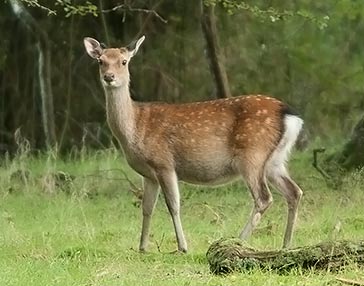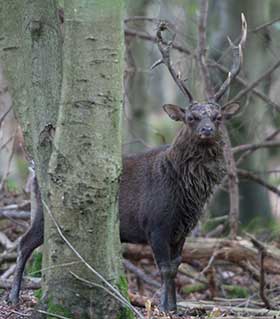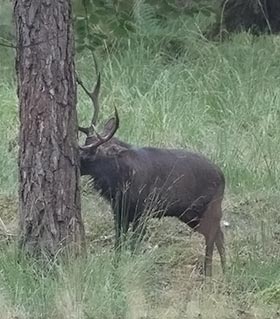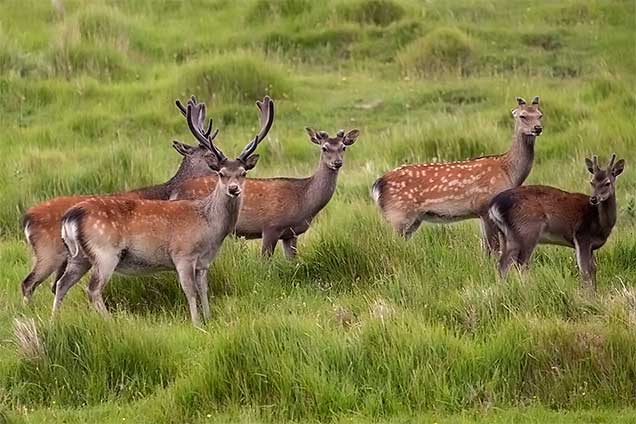New Forest Sika deer - identification and behaviour
How many: Around 100 sika deer are present. Together with red deer, they are the least abundant of the commonly seen New Forest deer.
Herds: Hinds often gather in small herds throughout the year, and are sometimes joined by a small number of stags. Stags, though, in the New Forest, other than during the rut, tend to be primarily solitary creatures.
Size: Of medium size, up to 82-90 centimetres (32-35 inches) at the shoulder. Stags are larger than hinds, and are compact, powerful-looking creatures, but often without the sheer bulk of red deer stags. Hinds are altogether squatter, dumpier, more cuddly-looking, round-faced creatures. Stags are sharper-faced, and appear to wear a perpetual frown.
Coat: Summer coat is red/brown with pale spots. In winter, hinds are grey/brown; stags dark grey, often almost black - both sexes are then unspotted.
Rear end: Large, pale, heart-shaped caudal, rump patch, edged with black; and a thin, dark line down the primarily white tail.
Antlers: Typically long, fairly straight, with 4 points on each.
Sounds: Year-round cough-like bark, and shrill, piping, high-pitched squeal. In the rut, stags use a similarly shrill, high-pitched whistling sound and loud, unbelievably awful-sounding screams.
Sika deer - recent arrivals in the New Forest

Well, everything’s relative - sika deer were introduced onto the Beaulieu estate at around the end of the 19th century. In 1904, two escaped to set up home in the wild, and then two more were deliberately released in 1905. And so the New Forest sika deer population was born.
Elsewhere in Britain at around the same time, numerous other small groups of sika deer were introduced, and have similarly colonised, so that now sika deer are found locally distributed in parts of England, and in good numbers in north and north-west Scotland.
In the New Forest, whilst primarily restricted to the south-east of the area, sika deer are well-established, and seem quite suited to life in coniferous and mixed woodlands. The population is, though, controlled by selective culling at between 100 and 200 animals.
Originally natives of Asia, sika deer are closely related to the indigenous red deer, and as with many introduced species, the arrival and spread of sika deer has not been without difficulties. It’s not that they’ve displaced any of our native deer, or even seriously threaten to do so. It's more that there’s a very real prospect of sika deer inter-breeding with the native red deer, which, if it were to happen, would put at risk through hybridisation the future of both pure-bred red and pure-bred sika.
To avoid such unfortunate consequences, the Forestry Commission manages the herds, keeping red deer north of the barrier that is the Southampton-Bournemouth railway line, and sika deer to the south. Given, though, that hybrids can not always be reliably distinguished in the field, one is left to wonder at the extent to which this strategy is a complete success.
Not surprisingly, sika deer and red deer share a number of characteristics. Appearance is similar, and segregation of the sexes outside the rutting period is common to both. And like red deer, sika deer can also seem to be remarkably unafraid, but whether standing in open woodland or visible simply as dark shapes amongst sombre pines, they always remain alert, watchful, waiting for passers-by to move along.

muddied and dishevelled after wallowing

by marking a Scots pine bole
Hinds are cuddly-looking, round-faced creatures in the best traditions of Bambi, but somewhat disconcertingly, stags always seem to manage a somewhat sinister, fierce-looking, scowl that is enough to unsettle many an onlooker.
As with the other species, though, it is during the rut that sika stags most declare themselves. Scent marking is important, using milky-white secretions from glands beside the eye and on the back legs – the preorbital and metatarsal glands – although sika stags also indicate presence to others of their kind by using their antlers to mark tree trunks. Known as bole scoring, this gouging can cause considerable damage to the trees, leaving quite deep, vertical ‘V’ shaped cuts that are clearly visible year-round as sap-stained scars.
Sound, though, to human observers, is inevitably the most noticeable indicator of the rut. But sika stags do not roar like red deer, or groan like fallow deer, or often bark like roe deer. No, sika stags whistle, a distinctive, piercing series of 3 to 5 notes often made in quick succession, followed by a lengthy spell of silence. It’s an eerie yet atmospheric sound that permeates the misty, often damp, autumnal woods, a sound that all naturalists should try to hear at least once in their lifetime.
Sika hinds, too, have an interesting repertoire of sounds, including a gruff bark similar to that of other deer species. But at other times, when alarmed, hinds give an incredibly far-carrying, rather spooky, high-pitched squeal that can sound uncannily like a dog whistle. A single note is sometimes heard before the animal takes flight, but when really uncertain about something, the squeals may be repeated at regular 15-20 second intervals for as long as 30 minutes.
Now that really is disconcerting in the half light of dusk or dawn, just as is the sika stag's scowl!

all with partly re-grown antlers 'in velvet'
(Photographed on the Isle of Purbeck, Dorset)
New Forest deer - find out lots more
References:
The History of British Mammals: Derek Yalden
Deer Watch: Richard Prior
New Forest Roe deer: John K. Fawcett
Roe deer: John K. Fawcett
Sika deer: Rory Putman
Fallow deer: Jochen Langbein and Norma Chapman
More links
Other related links
Search this site

Sadly, 58 animals were killed - 35 ponies, 13 cows, 8 donkeys and 2 sheep, whilst a further 32 were injured - 3 pigs, 9 donkeys, 11 cows and 9 ponies.
(Forty-three accidents occurred in daylight, 15 at twilight and 101 in the dark. Twenty-seven accidents were not reported by the driver involved).
Here's just one horrific example - Three donkeys killed in collision with van at notorious New Forest blackspot (Advertiser and Times)

